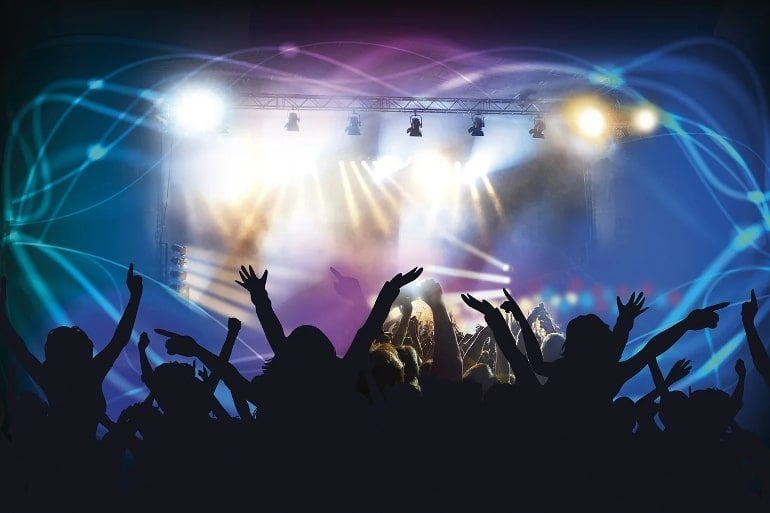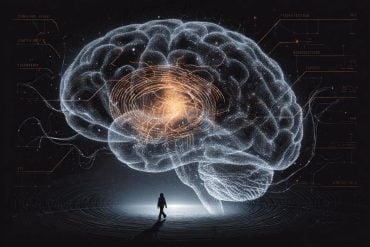Summary: People dance 11.8% more when very low-frequency bass is present in music, a new study reports.
Source: Cell Press
To find out how different aspects of music influence the body, researchers turned a live electronic music concert into a lab study.
By introducing levels of bass over speakers that were too low to hear and monitoring the crowd’s movements, scientists found that people danced 11.8% more when the very low-frequency bass was present.
The study appears November 7 in the journal Current Biology.
“I’m trained as a drummer, and most of my research career has been focused on the rhythmic aspects of music and how they make us move,” says first author Daniel Cameron, a neuroscientist from McMaster University.
“Music is a biological curiosity—it doesn’t reproduce us, it doesn’t feed us, and it doesn’t shelter us, so why do humans like it and why do they like to move to it?”
Cameron conducts research at the McMaster LIVELab, which connects science with live performance in a unique research theater. It is equipped with 3D motion capture, a Meyer sound system that can replicate various concert environments, and enhanced speakers that can produce extremely low frequencies, so low they were undetectable to the human ear.
For the Current Biology study, Cameron and colleagues recruited participants attending a LIVELab concert for electronic musical duo Orphx. The concertgoers were equipped with motion-sensing headbands to monitor their dance moves. Additionally, they were asked to fill out survey forms before and after the event. These forms were used to ensure the sound was undetectable, measure concert enjoyment, and examine how the music felt physically.

Throughout the 45-minute concert, the researchers manipulated the very-low bass-playing speakers, turning them on and off every two minutes. They found the amount of movement was 12% greater when the speakers were on.
“The musicians were enthusiastic to participate because of their interest in this idea that bass can change how the music is experienced in a way that impacts movement,” says Cameron. “The study had high ecological validity, as this was a real musical and dance experience for people at a real live show.”
The feeling of vibration through touch and the interactions between the inner ear and the brain have close links to the motor system. The researchers speculate these physical processes are at work in the neurological connection between music and movement. This anatomy can pick up on low frequencies and can affect the perception of “groove,” spontaneous movement, and rhythm perception.
“Very low frequencies may also affect vestibular sensitivity, adding to people’s experience of movement. Nailing down the brain mechanisms involved will require looking the effects of low frequencies on the vestibular, tactile, and auditory pathways,” says Cameron.
About this music and neuroscience research news
Author: Press Office
Source: Cell Press
Contact: Press Office – Cell Press
Image: The image is in the public domain
Original Research: Open access.
“Undetectable very-low frequency sound increases dancing at a live concert” by Daniel J. Cameron et al. Current Biology
Abstract
Undetectable very-low frequency sound increases dancing at a live concert
Does low frequency sound (bass) make people dance more?
Music that makes people want to move tends to have more low frequency sound, and bass instruments typically provide the musical pulse that people dance to.
Low pitches confer advantages in perception and movement timing, and elicit stronger neural responses for timing compared to high pitches, suggesting superior sensorimotor communication.
Low frequency sound is processed via vibrotactile and vestibular (in addition to auditory) pathways, and stimulation of these non-auditory modalities in the context of music can increase ratings of groove (the pleasurable urge to move to music), and modulate musical rhythm perception.
Anecdotal accounts describe intense physical and psychological effects of low frequencies, especially in electronic dance music possibly reflecting effects on physiological arousal.
We do not, however, know if these associations extend to direct causal effects of low frequencies in complex, real-world, social contexts like dancing at concerts, or if low frequencies that are not consciously detectable can affect behaviour.
We tested whether non-auditory low-frequency stimulation would increase audience dancing by turning very-low frequency (VLF) speakers on and off during a live electronic music concert and measuring audience members’ movements using motion-capture.
Movement increased when VLFs were present, and because the VLFs were below or near auditory thresholds (and a subsequent experiment suggested they were undetectable), we believe this represents an unconscious effect on behaviour, possibly via vestibular and/or tactile processing.






